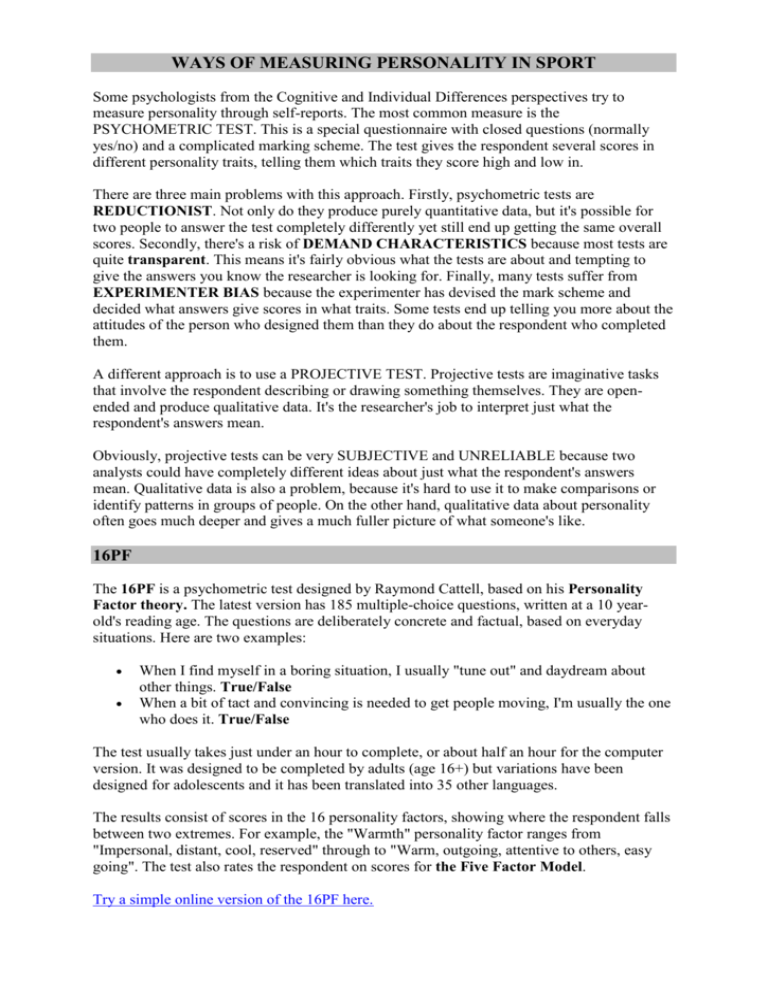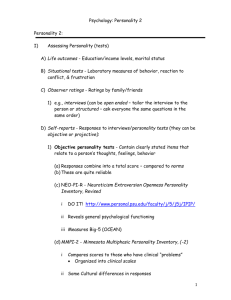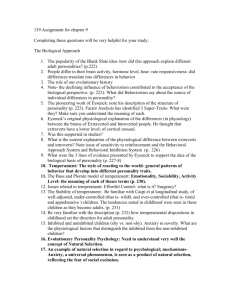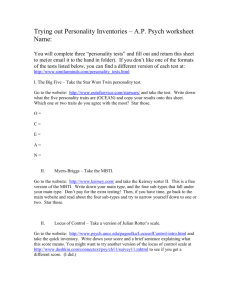ways of measuring personality in sport
advertisement

WAYS OF MEASURING PERSONALITY IN SPORT Some psychologists from the Cognitive and Individual Differences perspectives try to measure personality through self-reports. The most common measure is the PSYCHOMETRIC TEST. This is a special questionnaire with closed questions (normally yes/no) and a complicated marking scheme. The test gives the respondent several scores in different personality traits, telling them which traits they score high and low in. There are three main problems with this approach. Firstly, psychometric tests are REDUCTIONIST. Not only do they produce purely quantitative data, but it's possible for two people to answer the test completely differently yet still end up getting the same overall scores. Secondly, there's a risk of DEMAND CHARACTERISTICS because most tests are quite transparent. This means it's fairly obvious what the tests are about and tempting to give the answers you know the researcher is looking for. Finally, many tests suffer from EXPERIMENTER BIAS because the experimenter has devised the mark scheme and decided what answers give scores in what traits. Some tests end up telling you more about the attitudes of the person who designed them than they do about the respondent who completed them. A different approach is to use a PROJECTIVE TEST. Projective tests are imaginative tasks that involve the respondent describing or drawing something themselves. They are openended and produce qualitative data. It's the researcher's job to interpret just what the respondent's answers mean. Obviously, projective tests can be very SUBJECTIVE and UNRELIABLE because two analysts could have completely different ideas about just what the respondent's answers mean. Qualitative data is also a problem, because it's hard to use it to make comparisons or identify patterns in groups of people. On the other hand, qualitative data about personality often goes much deeper and gives a much fuller picture of what someone's like. 16PF The 16PF is a psychometric test designed by Raymond Cattell, based on his Personality Factor theory. The latest version has 185 multiple-choice questions, written at a 10 yearold's reading age. The questions are deliberately concrete and factual, based on everyday situations. Here are two examples: When I find myself in a boring situation, I usually "tune out" and daydream about other things. True/False When a bit of tact and convincing is needed to get people moving, I'm usually the one who does it. True/False The test usually takes just under an hour to complete, or about half an hour for the computer version. It was designed to be completed by adults (age 16+) but variations have been designed for adolescents and it has been translated into 35 other languages. The results consist of scores in the 16 personality factors, showing where the respondent falls between two extremes. For example, the "Warmth" personality factor ranges from "Impersonal, distant, cool, reserved" through to "Warm, outgoing, attentive to others, easy going". The test also rates the respondent on scores for the Five Factor Model. Try a simple online version of the 16PF here. EPI and EPQ-R The Eysenck Personality Inventory was designed in 1965 by Hans Eysenck to measure E and N scores. The Eysenck Personality Questionnaire followed 10 years later to measure all the dimensions in Eysenck's P-E-N Model of personality. The original version had 57 yes/no questions but the latest version (the EPQ-R) has 100. Eysenck also produces a short scale B-version for people who do not have the full hour to set aside; the latest short scale EPQ has 48 questions. Examples of questions include: Do you like telling jokes and funny stories to your friends? Yes/No Do you prefer reading to meeting people? Yes/No The EPQ also contains 12 "lie questions". These are scattered through the test and are designed to catch out people who are giving socially desirable answers. Typical lie questions are things like: Do you sometimes lie? Yes/No Have you ever cheated at a game? Yes/No When you think about it, everyone lies some times in their life and everyone's cheated at least once, even if it was when they were a child or over something trivial. Answering "No" to questions like these marks you out as a liar. The lie-scale gives as separate score, indicating how RELIABLE the rest of your results may be. Eysenck has come under a lot of criticism over the years for making grand claims for his theory and tests. The P-scale is considered particularly UNRELIABLE, being based on the responses and attitudes of convicts. Try a simple online version of the EPQ here. MBTI The Myers-Briggs Type Indicator is a different sort of psychometric test that measures how we perceive the world and make decisions. The current version contains 88 questions with forced choice answers."Forced choice" means the respondent has to choose between a couple of options in reply to a question. These options are a word pair or pair of opposed statements that link to the 8 factors in the Myers-Briggs Typology. Respondents are allowed to skip questions if they can't decide between the options and the whole test takes about 20 minutes. Here's a sample question: At work, I prefer to spend time on (a) ideas (b) people The test doesn't give number scores but groups respondents into types, described as a string of four letters. Everyone is either I or E (introverted or extraverted), S or N (sensing or intuitive), T or F (thinking or feeling) and J or P (judging or perceiving). There are 16 possible combinations, like ISTJ or ENFP. You can read descriptions of each of these here. The MBTI is popular with counselors and coaches and is particularly useful for analysing team dynamics. It's based on the idea that every personality type is equal. It has a lot of critics, however, who argue it has not been supported by experimental evidence. RELIABILITY is particularly low, with respondents who take the MBTI test a second type being assigned a different type 39%-76% of the time. Try a simple online version of the MBTI here. The Rorschack Inkblot Test This is a projective test devised by Hermann Rorschach (pronounced Raw-shock) in 1921. It involves ten distinctive "inkblot" designs on large pieces of card which are shown to the respondent, who tells the analyst what he or she perceives in the shape. Five of the inkblots are black and white, two red and white and three are multicolored. After viewing all ten inkblots, the respondent can look at them again and rotate them around, but the analyst makes not of every comment they make, no matter how trivial. The danger with this sort of test is that the analyst's interpretation of the answers can be completely SUBJECTIVE. To avoid this, most analysts use the Exner Scoring System. This calculates a score based on how vague the respondent is, how many images they perceive within the blot, the location of these images on the card, the symbols in their response and the form of their response (ie how similar is it to what the inkblot really looks like). The Exner system is based on the statistical frequency of certain answers being given. The Rorschach test is based on the Freudian theory that the unconscious mind can express hidden desires or conflicts through "slips" the conscious mind makes. There are a lot of critics of this idea, however. For one thing, the ten inkblots are now quite widely known, which means DEMAND CHARACTERISTICS are more likely than in Rorschach's day. The INTER-RATER RELIABILITY of the test is low, with different analysts giving different interpretations, even when using the Exner system. Also, the whole VALIDITY of the test has been attacked, because it's hard to explain just how it works. Some critics call it pseudoscience. Nevertheless, it is the second most popular test used by clinical and forensic psychologists (after the Minnesota Multiphasic Personality Inventory). Take a (silly!) online inkblot test here. Read this guide to the meaning of all 10 inkblots.








